Cepheus constellation lies in the northern hemisphere. It is one of the Greek constellations.
It was named after the mythical King Cepheus of Aethiopia, husband of Cassiopeia and father of Andromeda, both represented by neighboring constellations. Like most other constellations in the Perseus family, Cepheus was catalogued by the Greek astronomer Ptolemy in the 2nd century.
The constellation is home to VV Cephei and the Garnet Star (Mu Cephei), both among the largest known stars in the Milky Way, and to several well-known deep sky objects: the Bow-Tie Nebula, the Cave Nebula, the Wizard Nebula, the Iris Nebula, the Ghost Nebula, the Rosebud Nebula, and the Fireworks Galaxy.
Facts, location and map
Cepheus is the 27th largest constellation in the night sky, occupying an area of 588 square degrees. It is located in the fourth quadrant of the northern hemisphere (NQ4) and can be seen at latitudes between +90° and -10°. The neighboring constellations are Camelopardalis, Cassiopeia, Cygnus, Draco, Lacerta, and Ursa Minor.
The constellation name Cepheus is pronounced /ˈsiːfiəs/. In English, the constellation is known as Cepheus or the King. The genitive form of Cepheus, used in star names, is Cephei (pronunciation: /ˈsiːfiaɪ/). The three-letter abbreviation, adopted by the International Astronomical Union (IAU) in 1922, is Cep.
Cepheus belongs to the Perseus family of constellations, along with Andromeda, Auriga, Cassiopeia, Cetus, Lacerta, Pegasus, Perseus, and Triangulum.
Cepheus has one star with known planets and contains no Messier objects. The brightest star in the constellation is Alderamin, Alpha Cephei. There are no meteor showers associated with Cepheus.
The constellation contains five formally named stars. The star names approved by the International Astronomical Union (IAU) are Alderamin, Alfirk, Errai, Garnet Star, and Kurhah.
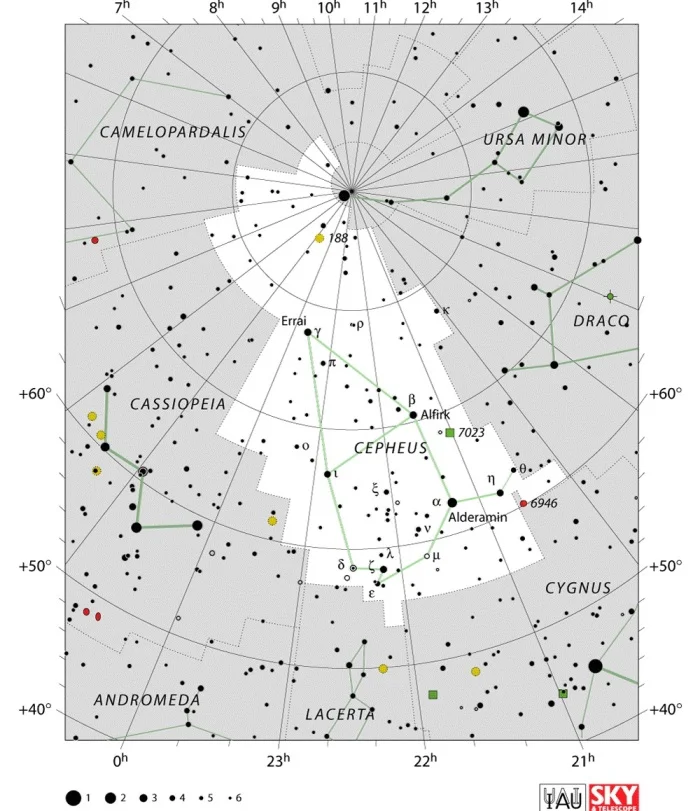
Cepheus constellation map by IAU and Sky&Telescope magazine
Cepheus myth
The constellation represents Cepheus, the king of Ethiopia and Cassiopeia’s husband in Greek mythology. Zeus placed him in the sky after his tragic end because he was descended from one of Zeus’ loves, the nymph Io. Cepheus ruled not the modern-day Ethiopia, but the stretch of land between the southeastern Mediterranean and the Red Sea, the area that contains parts of the modern-day Egypt, Israel and Jordan.
Cepheus’ wife Cassiopeia was a very vain woman. Once, she boasted that she was more beautiful than the Nereids (sea nymphs, one of them the wife of the sea god Poseidon), which angered the nymphs and Poseidon, who then sent a sea monster, represented by the constellation Cetus, to ravage Cepheus’ land.
Cepheus turned to an oracle for advice on how to prevent a calamity and the oracle told him that the only way to appease Poseidon was to sacrifice his daughter Andromeda to the monster.
Desperate, Cepheus and Cassiopeia did this, leaving their daughter chained to the rock for Cetus to find. Luckily, the hero Perseus found the princess first, rescued her and defeated the monster. Later, he married Andromeda.
Perseus and Andromeda were celebrating their wedding when Phineus, Cepheus’ brother, turned up, claiming that she had been promised to him first. Phineus and his followers asked that Andromeda be turned over to them, but Cepheus refused them and there was a fight. Perseus tried to fight off all his opponents, but he was sorely outnumbered and had to use the head of Medusa to turn his enemies into stone. Unfortunately, the king and queen did not look away from the Gorgon’s head in time and were turned to stone, too.
Cepheus stars
Alderamin – α Cephei (Alpha Cephei)
Alpha Cephei is the brightest star in the constellation. It is a white class A star, currently evolving from a main sequence star into a subgiant. It is approximately 49 light years distant. Its traditional name, Alderamin, is derived from the Arabic phrase að-ðirā‘ al-yamīn, which means “the right arm.” The star has an apparent magnitude of 2.5141. It rotates at a very high speed, at least 246 km/s, and completes one revolution within 12 hours or less.
Alderamin never sets below the horizon when observed from Europe, northern Asia, Canada and most North American cities. It can be seen by the unaided eye.
Alfirk – β Cephei (Beta Cephei)
Beta Cephei is a triple star with an apparent magnitude that varies from 3.15 to 3.21 within a period of 0.1904844 days. It is approximately 690 light years distant.
The star’s traditional name, Alfirk, derives from the Arabic al-firqah, which means “the flock.” Alfirk serves as the prototype for a class of stars known as the Beta Cephei variable stars. These stars are main sequence stars with masses ranging between 7 and 20 solar masses. They show variations in brightness as a result of pulsations of their surfaces. The stars typically change in brightness by 0.01 to 0.3 magnitudes with periods of 0.1 to 0.6 days.
The brightest component in the Beta Cephei system, Alfirk A, is a blue giant classified as a B2IIIev class star. The –ev suffix stands for “spectral emission that exhibits variability.” The star is a slow rotator and takes about 51 days to complete a single revolution, at a rotational speed of 28 km/s.
δ Cephei (Delta Cephei)
Delta Cephei is a double star with an apparent magnitude varying between 3.48 and 4.37. It lies approximately 891 light years from the solar system.
Delta Cephei serves as the prototype of a class of stars known as the Cepheid variable stars, or simply Cepheids. The only star belonging to this class that is closer to the solar system is Polaris in the constellation Canis Minor.
Delta Cephei’s variations in luminosity and spectral type result from the pulsation of the star. The star’s spectral type varies from F5 to G3 over a period of 5.36634 days (5 days, 8 hours, 47 minutes and 32 seconds). The brighter component of the binary is classified as a yellow-white F-class supergiant. The companion is believed to be a B-class star and is located 41 arc seconds away. It has an apparent magnitude of 7.5.
Cepheids typically form with masses 3-30 times that of the Sun, then pass through the main sequence stage as B-class stars and, once they have burnt up the hydrogen in their core, their helium core loses stability and begins to contract and expand at regular intervals and they undergo stages of nuclear burning. Cepheids are high-mass stars in the late stages of their existence that are luminous enough to be seen by the unaided eye and easily found in the neighbouring galaxies. Since their luminosities are directly tied to their pulsation periods, astronomers only need to measure the stars’ visual magnitude to determine their distance and the distances of the galaxies where the stars are located.
The Delta Cephei system has a mean apparent magnitude of 4.07.
Errai – γ Cephei (Gamma Cephei)
Gamma Cephei is another binary star in Cepheus. It has an apparent magnitude of 3.22 and is approximately 45 light years distant. The star’s traditional names are Alrai, Er Rai and Errai, derived from the Arabic ar-rā‘ī, which means “the shepherd.” Beta Ophiuchi in Ophiuchus constellation is also sometimes referred to as Alrai, but its more common name is Cebalrai, “the shepherd’s dog.”
Gamma Cephei is classified as an orange subgiant (spectral type K1III-IV) and is believed to be 6.6 billion years old. It is visible to the unaided eye. The companion has about 0.409 solar masses and is thought to be an M4 class red dwarf.
The first confirmed extrasolar planet was discovered in the orbit of the brighter component in the system in 1989. Later, the discovery was retracted due to insufficient evidence, but measurements in 2002 once again pointed to a likely existence of the planet.
Due to the precession of the equinoxes, Gamma Cephei will replace Polaris, Alpha Canis Minoris, as the northern pole star around the year 3,000 AD.
ζ Cephei (Zeta Cephei)
Zeta Cephei is an orange subgiant belonging to the spectral type K1 IV. It has an apparent magnitude of 3.39 and is approximately 730 light years distant. The star marks the left shoulder of Cepheus. It is eight times more massive than the Sun, about 3,600 times more luminous, and it has a surface temperature of 4,310 kelvins. It is a suspected binary as well as a suspected variable star.
η Cephei (Eta Cephei)
Eta Cephei is an orange giant star belonging to the spectral type K0, approximately 45 light years distant. The star is notable for its high proper motion. It is sometimes known by its traditional name Al Kidr.
Garnet Star – μ Cephei (Mu Cephei)
Mu Cephei is a red supergiant, approximately 2,090 light years distant. The star is too far away for its distance to be certain, though. It has the stellar classification M2Ia.
Mu Cephei has an apparent magnitude of 4.08 and it is one of the most luminous stars known. It is known as Herschel’s Garnet Star, after the astronomer William Herschel who discovered the planet Uranus in 1781. Herschel described Mu Cephei as “a very fine deep garnet colour, such as the periodical star ο Ceti.”
In 2024, the International Astronomical Union (IAU) formally approved the name Garnet Star for Mu Cephei.
Mu Cephei is a class M bright supergiant and one of the largest stars ever observed in the entire galaxy. It has a radius 972 times that of the Sun. If it were not obscured by interstellar dust, it would shine at magnitude 1.97.
Mu Cephei is classified as a semiregular variable star. It was a prototype for the obsolete class of stars known as the Mu Cephei variables. The star’s apparent magnitude varies between magnitude 3.62 and 5 in a period of 2 to 2.5 years, without a recognizable pattern.
The star has started to fuse helium into carbon and it is approaching its final stages of life. It is unstable and expected to go out as a supernova in the relatively near future, which might mean several millions of years.
VV Cephei (HD 208816)
VV Cephei is an eclipsing binary star, almost as large as the Garnet Star. Its radius spans between 7.5 and 8.8 Astronomical Units. The star is approximately 2,400 light years distant. It has an apparent magnitude of 4.91.
VV Cephei consists of a red hypergiant and a blue companion star. The hypergiant, VV Cephei A, is the third largest star known. It has a solar radius between 1,600 and 1,900.
V381 Cephei
V381 Cephei is a red supergiant with an apparent magnitude of 5.66, approximately 3,663 light years distant. It is a pulsating variable star. It belongs to the spectral class M1lbpe+ and has about 9 or 10 solar masses.
Kruger 60
Kruger 60 is a binary star composed of two red dwarfs that orbit each other with a period of 44.6 years. The star system is only 13.15 light years (4.03 parsecs) distant. The stars have apparent magnitudes of 9.59 and 11.40.
In about 88,600 years, Kruger 60 will make its closest approach to the solar system and come within 1.95 parsecs.
Deep sky objects in Cepheus
Fireworks Galaxy (NGC 6946, Arp 29, Caldwell 12)
The Fireworks Galaxy is an intermediate spiral galaxy in Cepheus. It has an apparent magnitude of 9.6 and is approximately 22 million light years distant. It lies on the border between Cepheus and Cygnus.
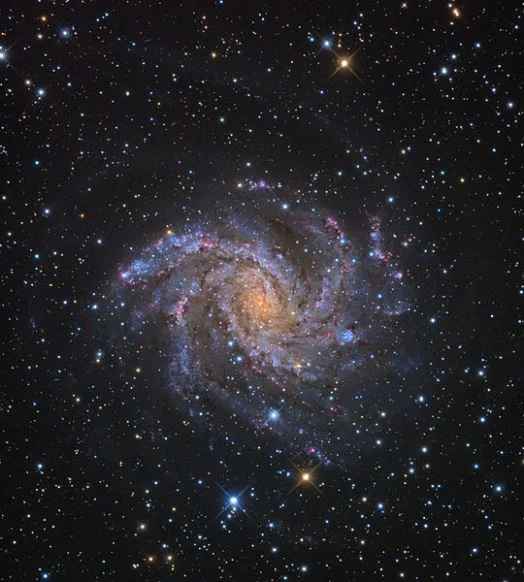
The Fireworks Galaxy (NGC 6946), image: Adam Block/Mount Lemmon SkyCenter/University of Arizona (CC BY-SA 4.0)
The galaxy was discovered by William Herschel in September 1798. Nine supernovae have been observed in it over the last century: SN 1917A, SN 1939C, SN 1948B, SN 1968D, SN 1969P, SN 1980K, SN 2002hh, SN 2004et, and SN 2008s.
Wizard Nebula – NGC 7380
NGC 7380 is an open star cluster also known as the Wizard Nebula. It was discovered by Caroline Herschel in 1787. The cluster is embedded in a nebula which is about 110 light years in size.
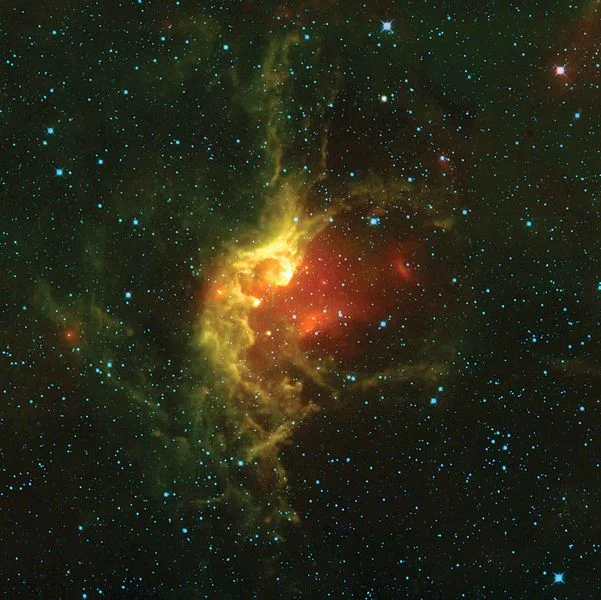
The Wizard Nebula (NGC 738), photo: NASA, JPL-Caltech, WISE Team
The cluster is located with the Milky Way Galaxy and is approximately 7,000 light years distant from the solar system. The stars in it are less than five million years old, which makes NGC 7380 a young open cluster.
NGC 7538
NGC 7538 is an emission or reflection nebula, approximately 9,100 light years distant.
The nebula contains the biggest protostar (a large mass formed when gas inside a giant molecular cloud contracts) discovered to date. The protostar, located in the Perseus Spiral Arm of the Milky Way Galaxy, is 300 times the size of the solar system.
NGC 188 (Caldwell 1)
NGC 188 is an open star cluster, approximately 5,400 light years distant. It was discovered by the English astronomer Sir John Frederick William Herschel in 1825.
It is one of the oldest known open clusters. It lies about five degrees away from the North Celestial Pole.
Iris Nebula (NGC 7023, Caldwell 4)
The Iris Nebula (NGC 7023) is a reflection nebula with an apparent magnitude of 6.8. It is approximately 1,300 light years distant. The object is really a star cluster embedded inside a nebula.
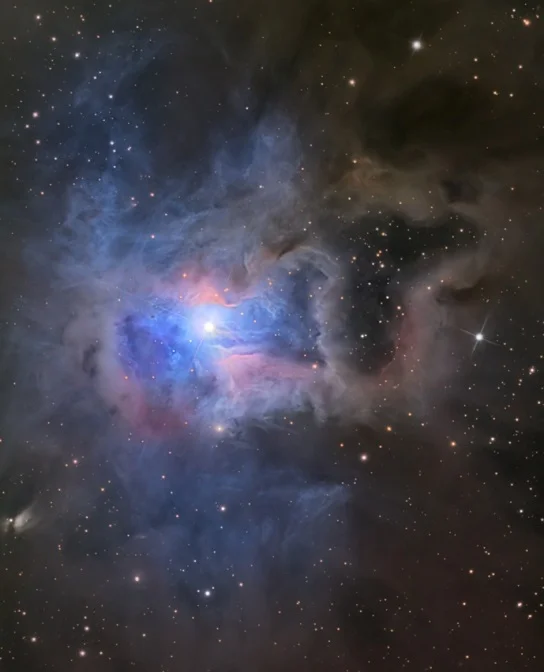
The Iris Nebula (NGC 7023), image: Adam Block/Mount Lemmon SkyCenter/University of Arizona (CC BY-SA 4.0)
The Iris Nebula is lit by the star SAO 19158 and it lies close to two relatively bright stars, T Cephei, which is a Mira variable, and Beta Cephei, which has an apparent magnitude of 3.23.
Rosebud Nebula – NGC 7129
The Rosebud Nebula is a reflection nebula associated with a young open cluster. The cluster contains more than 130 young stars, believed to be less than a million years old. It is approximately 3,300 light years distant and has an apparent magnitude of 11.5.
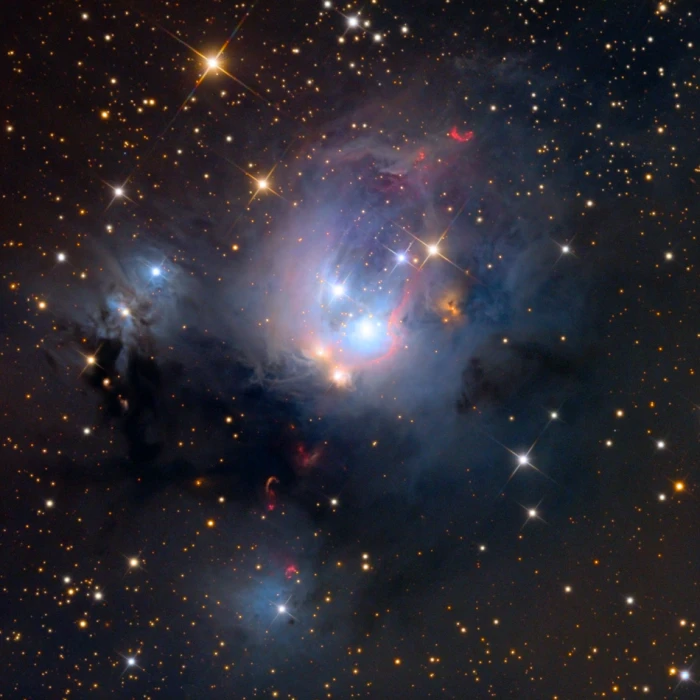
Rosebud Nebula (NGC 7129), image credit: Adam Block/Mount Lemmon SkyCenter/University of Arizona (CC BY-SA 4.0)
NGC 7142
NGC 7142 is another open cluster in Cepheus. It has an apparent magnitude of 9.3 and is approximately 6,200 light years distant. The cluster lies in the vicinity of the nebula NGC 7129 and is believed to be obscured by an interstellar cloud.
The cluster is thought to be one of the oldest open clusters known, even if its age is difficult to determine because it is unknown just how obscured it is by interstellar reddening. Curiously, for an old cluster, NGC 7142 contains an uncommonly high number of young blue stars.